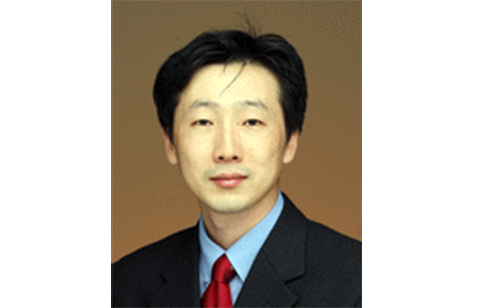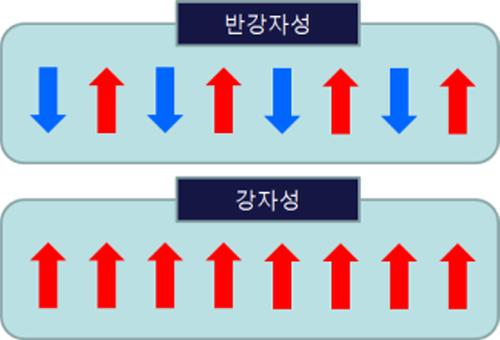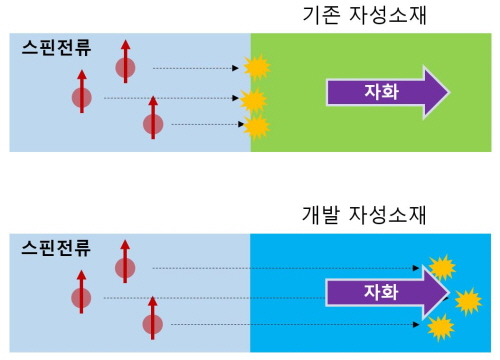Professor Kyung-Jin Lee’ team and NSU researchers develop a low-power,
high-speed new spin material for use in magnetic RAM.
Expectations are high for the development of a core material technology for next generation magnetic RAM.

▲ Professor Kyung-Jin Lee, Department of Materials Science and Engineering, Korea University
Teams led by Professor Kyung-Jin Lee of Korea University’s Department of Materials Science and Engineering, and Professor Hyunsoo Yang of the National University of Singapore developed a core material structure for next generation Magnetic Random Access Memory (MRAM) capable of low-power, high-speed switching.
The study was published online in Nature Materials on December 3, as a result of collaborations with Professor Awano of the Toyota Technological Institute (TTI) in Japan and Professor Qiu of Tongji University in China.
- Paper Title: Long spin coherence length and bulk-like spin-orbit torque in ferrimagnetic multilayers.
- Authors: J. Yu (NUS), D. Bang (TTI), R. Mishra, R. Ramaswamy (NUS), Jung Hyun Oh, HyeonJong Park, Yunboo Jeong (Korea University), P. V. Thach (TTI), Dong-Kyu Lee, Gyungchoon Go, Seo-Won Lee (Korea University), Y. Wang, S. Shi (NUS), X. Qiu (Tongji University), H. Awano (TTI), Professor Kyung-Jin Lee (co-corresponding author, Korea University), Professor Hyusoo Yang (co-corresponding author, NUS).
MRAM can maintain information in the absence of an external power supply and is capable of high-speed operation, and therefore the world’s semiconductor companies are competing to develop this next generation memory. However, in order to expand the market power of MRAM, new technology is needed to switch the magnetization direction of the thick magnetic layer to a low current.
The operation of MRAM consists of spin torque generated by injecting a transverse spin current* into magnetic material. Existing magnetic materials face one limitation, in that it is impossible to switch the thick magnetic layer due to the characteristic manner in which the lateral spin current disappears from the surface of the material.
* Spin current: A typical current is the charge flow of electrons. The spin current is a phenomenon in which spin, another characteristic of electrons, moves. The spin current can appear without the actual movement of the charge and can be free from power losses due to Joule heating.
In this study, we have theoretically and experimentally demonstrated a new material structure, a ferrimagnetic multi-layer film that has an atomic antiferromagnetic* spin arrangement, in which the transverse spin current is not lost but maintained across the entire surface of the thick film. This achieved a spin conversion efficiency 20 times higher than existing materials.
* Anti-ferromagnetism: a characteristic or property in which the spins of two adjacent atoms align pointing in opposite directions. In contrast, ferromagnetism is a characteristic whereby spins point in the same direction. A typical magnetic material is ferromagnetic.
* Ferrimagnetic multi-layer film: A thin film stacked repeatedly so that atomic layers made of different elements crisscross each other repeatedly.
In this study, when one layer of cobalt (Co) and one layer of terbium (Tb) were cross-sectionally stacked, the Co spin and the Tb spin were antiferromagnetically opposite to each other.
If this new material is applied to a spin-torque-based MRAM, which has attracted attention as a form of next-generation memory, it is expected to contribute to the expansion of the spin-torque MRAM market because of its increased spin torque efficiency and ultra-high integration capability.
This material, which can be applied to spin-orbit torque MRAM, which is being developed for future MRAM technology, can dramatically reduce standby power compared to SRAM due to its high-speed operation and non-volatile characteristics, and is likely to be used as memory for mobile devices, wearables, or IoT memory requiring low power. Professor Lee Kyung-Jin Lee said, "This study solved the difficulties for ultra-high integration of MRAM by experimentally implementing the quantum mechanical principle, in that the lateral spin current is maintained within the magnetic material. It is a good example showing that the understanding of basic sciences can be used to solve the core problems of application devices.”
The results of this research were carried out with support from the Ministry of Science and ICT's Future Material Discovery Project, the National Research Foundation of Korea’s Mid-career Researcher Program, the KIST Joint Research Lab Project, the Samsung Electronics Future Technology Development Project, and the Singapore Government Project
[Terminology]
1. MRAM (Magnetic Random Access Memory)
○ Unlike conventional silicon-based memory, MRAM is a kind of nonvolatile memory in which data is stored by the magnetization direction of a thin magnetic film. In general, in a ferromagnetic / oxide / ferromagnetic structure, which is a magnetic tunnel junction structure, two states (0, 1) are represented according to the relative magnetization directions (parallel and antiparallel) of two ferromagnetic materials. The 2007 Nobel Prize for Physics was awarded for a memory structure based on the giant magnetoresistance phenomenon.
2. Spin current
○ Spin current refers to the movement of quantum mechanically defined spin angular momentum, and basically refers to a net shift of up-spin (+ 1 / 2ℏ) and down-spin (-1 / 2ℏ). Since such a spin current can induce magnetization reversal of a magnetic material, it is utilized as a driving source of most spintronics devices including MRAM. In particular, the spin current can appear without the actual movement of the charge and can be free from power loss due to Joule heating.
[Schematic illustration of spin currents]
3. Spin-orbit Torque
○ A new physical principle based on the interaction between electron spins and orbits. It controls magnetic information using the spin torque generated from the current flowing in the metal conductor adjacent to the ferromagnetic substance. Generally, because it is known that the larger the atomic number is, the larger the spin-orbit torque is, heavy metals are mainly used as metal conductors.
4. Anti-ferromagnetism
○ A characteristic referring to when the spins of two adjacent atoms face opposite directions. In contrast, ferromagnetism is a characteristic in which both adjacent spins are oriented in one direction. In general, magnetic material is ferromagnetic.
[Antiferromagnetic, ferromagnetic schematic illustration: arrow = atomic spin]
5. Ferrimagnetic multilayer film
○ Ferrimagnetism is the intermediate property between ferromagnetic and antiferromagnetic. Even if the spins of two adjacent atoms are opposite to each other, they are classified as ferrimagnetic if the two kinds of atoms are different. The ferrimagnetic multilayer film is formed by repeatedly crossing atomic layers composed of different elements in the direction of the thickness. In this case, the spin direction of the two atoms are antiferromagnetic. In this study, a ferrimagnetic multilayer film was formed by alternately stacking a cobalt (Co) atomic layer and a terbium (Tb) atomic layer, at which the Co spin and the Tb spin have opposite directions due to the quantum mechanical exchange interaction.
[Figure]


Schematic illustration of spin current absorption.
In existing magnetic materials, the spin current generated from the outside disappears from the surface of the magnetic material, while in developed magnetic materials (ferrimagnetic multilayer film with an antiferromagnetic spin array), the spin current is maintained all the way through to the deep portion of the magnetic layer.
This property is due to the excellent spin conformability of ferrimagnetic multi-layer films with antiferromagnetic spin array, which makes it possible to easily switch the magnetization of thick ferrimagnetic layers.



